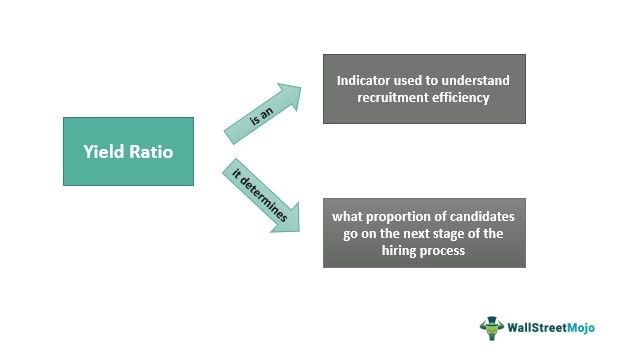Table Of Contents
What Is Yield Ratio?
The yield ratio is a recruitment indicator that reflects the percentage of applicants that go on to the next stage of the recruiting process after completing a previous stage. The ratio not only monitors the progression from one stage to the next (such as from the application to the screening calls), but it also measures the progression from the beginning to the end (number of applications to the number of hires).

When applied appropriately, recruitment analytics have the potential to provide a great deal of information. For instance, they may be able to tell whether or not the efforts put into external recruiting are paying off. Alternatively, they could bring to light issues with diversity and meritocracy.
Key Takeaways
- Yield ratios are metrics used in recruitment to quantify the proportion of applicants who advance from one stage of the hiring process to the next.
- They are used to evaluate the effectiveness of various recruiting strategies and methodologies.
- The yield ratio can be computed at any point in the recruitment process, from the initial application to the final hire.
- They are utilized as a tool for evaluating the effectiveness of various tactics and approaches to the recruitment process.
Yield Ratio In Recruitment Explained
Yield ratios are indicators used in recruitment to determine what proportion of candidates go on to the next stage of the hiring process. These metrics assess the progression of applicants from one phase to the next. In addition, they are utilized as a tool for evaluating the effectiveness of various approaches to the recruitment process.
In recruiting, one of the metrics utilized to monitor the progression of applicants through the various stages of the hiring pipeline is known as a yield ratio. Examining the proportion of applicants that move on to the next stage of the recruiting process is one of the essential recruitment metrics that can be tracked. Doing so may assist employers in locating blind spots and missed chances in the process.
The recruitment yield ratio is one of the most important critical performance metrics in the recruiting process. In most contexts, yield ratios are utilized to determine how many applicants were ultimately selected for further consideration compared to the total number of candidates. However, its use goes much beyond that. It can be expanded to reflect every stage of the employment process and sources of hire.
Yield Ratio Formula
The yield ratio formula is as follows:
Yield Ratio = number of hirable candidates resulting from recruitment stage n / Total number of candidates who came in recruitment stage n
Here, 'stage n' means the number of recruitment stage.
So, for instance, the recruitment phases may be:
- Interview
- Preliminary evaluation
- Last round of interviews
The ratio depends entirely on the stage for which one is attempting to calculate yield.
The ratio can be computed at any point in the recruitment process, from the initial application to the final hire. This will estimate the average number of candidates a firm needs to consider before hiring.
Examples
Let us look at some yield ratio examples:
Example #1
A company wants to determine if recruiting candidates from online job boards is effective. It uses the yield ratio calculation to see how many candidates who apply for a specific role from an online job board are qualified enough to pass the initial screening and come in for an interview. Over two weeks, the company received 635 applications and invited 36 candidates for interviews. It completes the following calculation to find the yield ratio:
Yield ratio for recruitment stage one = 36 / 635 = 0.06 = 6%
This means that around 6% of candidates are qualified enough to invite for an interview.
Example #2
For example, if 150 people (110 females and 40 males) applied through the job board. Consider 10 of them made it to the final round of interviews. Out of which 9 of them were male, the calculation would look like this:
10 / 150 x 100% = 6.6%
The female yield ratio would look like this:
1 / 110 x 100% = 0.9%
That would represent a 0.9% push-through rate for females in this stage of the recruitment process, which would be very low. So, as a solution, looking at the process and any inherent biases that discriminate against females can help.
Importance
Regarding recruiting and selection, yield ratios almost seldom stand on their own as good percentages. Therefore, assessing data and comparing HR indicators over time must be an ongoing operation in companies. They may be able to arrive at more accurate findings due to this. The longer a firm runs its process, the lower yield ratios will be, making it more efficient.
Also, hiring quality should not suffer if the number of candidates who make it through each step is reduced. It should indicate that the firm is utilizing more effective screening methods. Also, when measuring the quality of a particular source, such as an external recruiter, passing more candidates from the "application" phase to the "screening call" phase could be a good thing. One specific recruiter may be responsible for bringing in many qualified applicants.
The recruiting yield pyramid presented before might be interpreted as representing expected ratios when hiring for a particular role. In addition, yield metrics can assist in determining whether or not recruiting techniques, and sources are producing the desired results.
One could also compare recruitment ratios from different sources, such as recruitment agencies, employee referrals, and job boards, to see which source is most effective. Comparing recruitment ratios from different sources can help employers identify gaps and opportunities in the hiring process by looking at what percentage of candidates pass from one stage to the next.
A yield ratio helps uncover any interview bias or inherent biases in the recruiting process. Interview biases are prejudices that are brought up throughout the interview process.
